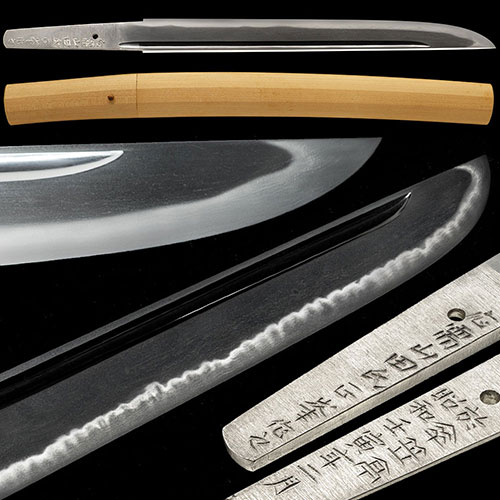
正峯 脇差Masamine(Seihou) Wakizashi
No.477988人間国宝 隅谷正峯 昭和壬寅年二月 兼光写し互の目丁子に金筋砂流し頻りに掛る名品 一尺Ningen Kokuhou (Living National Treasure) Masamine(Seihou) Showa Mizunoetora February Kanemitsu Copy Gunome Chouji Kinsuji Sunagashi Frequently hung masterpiece 30.4 cm
- 銘表Mei-Omote
- 応需山田氏正峯作之 応需山田氏正峯作之 OujuYamadashi Masamine(Seihou) korewotsukuru
- 裏銘Ura-mei
- 於傘笠亭 昭和壬寅年二月於傘笠亭 昭和壬寅年二月 Sanryuutei site Syouwa Mizunoetora February
- 登録証Registration
- 福岡県 Fukuoka 平成5年7月15日 7/15/5(Heisei)
- 法量Size
-
刃長 30.4cm (一尺) 反り 0.0cm
元幅 3.0cm 元重 0.73cm 茎長 12.2cm 重量 268gHachou 30.4cm (一尺) Sori 0.0cm
Moto-Haba 3.0cm Moto-Kasane 0.73cm Nakago-Chou 12.2cm Weight 268g - 姿Shape
- 鎬造、三つ棟、身幅広く、僅かに内反り。Shinogidukuri, Mitsumune, Wide Mihaba, a slightly inward Sori
- 鍛Kitae
- 小板目肌つみ、柾目肌交じり、地沸微塵につき、地景入り、鉄冴える。Small Itamehada tsunami, Mixed Masame, Jinie fine and thick, Chikei , Iron is clear.
- 刃文Hamon
- 互の目に、丁子刃交じり、匂出来、小沸付き、金筋・砂流し頻りに掛り、足よく入り、匂口明るい。Gunome, Mixed Choujiba, Nioideki ,Konie, Kinsuji, Sunagashi kakari, There are many Ashi, Nioikuchi is bright.
- 帽子Boushi
- 乱れ込んで先掃きかけて小丸。Midarekonde sakihakikakete Komaru
- 茎Nakago
- 生ぶ、先栗尻、鑢目切、目釘孔一。彫物は、表裏に棒樋を掻き流す。Ubu, Sakikurijiri, Yasurimegiri, Mekugiana is 1. The sculpture scoops Bouhi on the front and back.
- ハバキHabaki
- 金着一重。Single gold.
- 彫物Carving
- 彫物は、表裏に棒樋を掻き流す。The sculpture scoops Bouhi on the front and back.
- 説明Drscription
- 正峯は大正十年石川県に生まれ、本名を隅谷与一郎と言い、立命館大学を卒業後、桜井正幸刀匠に学び、昭和十七年には広島県にある興国日本刀鍛錬場に入る。戦後は昭和三十年に、鍛錬所「傘笠亭(さんりゅうてい)」を郷里に構え、傘笠亭、傘笠、両山子とも号している。翌同三十二年から八年間新作刀展で連続入賞、同四十一年、四十二年と連続で正宗賞の栄誉に輝き無鑑査刀匠となり、同五十六年には重要無形文化財指定を受ける。平成十年、七十七歳没。主な作品に、伊勢神宮式年遷宮御神宝纏御太刀(昭和39年)、伊勢神宮式年遷宮御神宝太刀十二振(同44年)、伊勢神宮式年遷宮御神宝太刀十六振(平成元年)のほか、皇太子妃、秋篠宮真子内親王の守り刀などがある。飛鳥・奈良時代から現代にいたる刀剣技術を研究し、なかでも鎌倉期の一文字や長船長光、青江などを得意とした。
この刀は、身幅広い南北朝の短刀の姿に、小沸微塵につき、小板目肌に柾目肌交じり、冴えた地鉄に、互の目丁子に、金筋・砂流し頻りに掛るなど、兼光をよく写した傑作である。Masamine(Seihou) was born in Ishikawa prefecture in the 10th year of the Taisho era, and his real name is Yoichiro Sumitani. After the war, in 1955, he set up a training center "Sanryu-tei" in his hometown and called it Sanryu-tei, Sanryu, and Ryouzanshi. The following year, he won a prize at the New Sword Exhibition for eight years from 1923, and became an uninspected swordsmith with the honor of the Masamune Award for 41 and 42 years in a row, and was designated as an important intangible cultural property in 1956. In 1998, he died 77 years old. Major works include "Ise Jingu-style yearly transitional shrine god treasure sword (1964)", "Ise Jingu-style yearly transitional palace god treasure sword 12 swings (1944)", "Ise Jingu style yearly transitional palace god treasure" In addition to "Tachi 16 swings (1989)", there are also the guardian swords of the Crown Princess and Mako Akishinomiya. He studied sword techniques from the Asuka / Nara period to the present day, and was particularly good at Ichimonji in the Kamakura period, Nagamitsu, and Aoe.
This sword is a masterpiece of Kanemitsu, such as Tanto of Mihaba wide Nanbokuchou, Konie finely attached, small Itamehada mixed with Masamehada, clear Jitetsu, Gunomechouji, Kinsuji and Sunagashi frequently.


